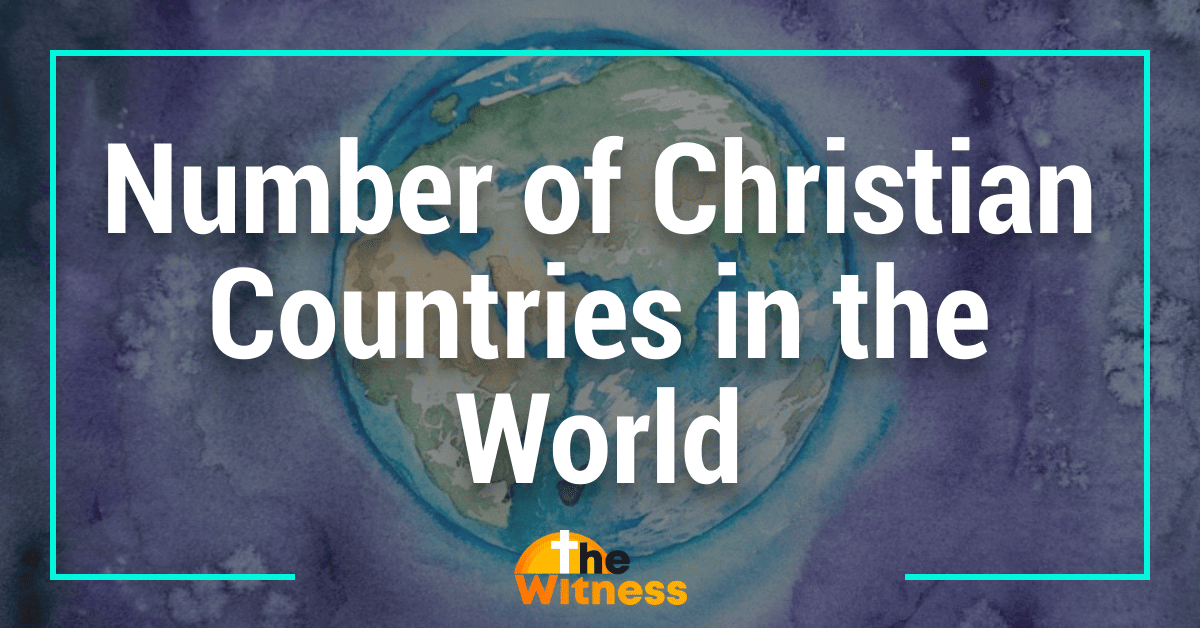Christianity stands as one of the most widespread religions globally, not only in terms of followers but also in geographic distribution. While it originated in the Middle East over two millennia ago, it has since reached every corner of the world, with its presence established through an array of churches, denominations, and doctrines. The global adherence to Christianity has resulted in a substantial number of countries where Christians make up either a majority or a significant minority of the population. Estimating the exact number of Christian countries can be challenging due to factors like secular governance, religious freedom, and the distinction between cultural and devout religious practice.

Christian Countries in the World

Given the historical spread and influence of Christianity, it has shaped cultures and societies on every continent. Notably, Christianity is recognized as an official state religion in several nations, signifying its integral role in the public and political spheres of these countries. Christianity’s reach extends far and wide, with countries like the United States, Brazil, and Mexico having the largest Christian populations. These populations encompass multiple denominations, reflecting the religion’s internal diversity, from Catholicism and Orthodoxy to Protestantism and Pentecostalism. The continuous growth and demographic changes within global Christianity provide insight into social trends and potential shifts in religious landscapes.
Key Takeaways
- Christianity is a major global religion with a wide distribution across countries.
- Many countries have a significant Christian majority, and it is the state religion in some.
- The diversity in denominations and trends in Christian demographics affect its societal role.
Definition and Core Beliefs of Christianity
Christianity is a faith built on the life and teachings of Jesus of Nazareth, whose divine role and mission are recognized by adherents. This faith is characterized by the belief in one God and the life, death, and resurrection of Jesus, marking it as a major world religion with diverse expressions in Catholic, Protestant, and Orthodox traditions.
Christian Beliefs

Christianity is based on a set of key doctrines, which include the belief in one God, the Trinity, and salvation through Jesus Christ. Salvation, a central tenet of Christian faith, is believed to be available to all through faith in Jesus and his atoning sacrifice on the cross. The core beliefs are often encapsulated in historic creeds like the Nicene Creed, affirming the divine nature of Jesus and the Holy Spirit.
- Trinity: One God in three persons—the Father, Son, and Holy Spirit.
- Incarnation: Jesus Christ is both fully divine and fully human.
- Resurrection: Jesus’s resurrection from the dead assures eternal life for believers.
Christian Denominations
Christianity includes several denominations, with the largest being the Roman Catholic Church, Protestant churches, and Orthodox Christian churches. Each tradition maintains its own interpretations and practices:
- Catholicism: Structured under the leadership of the Pope, Catholicism emphasizes the sacraments and the authority of the church.
- Protestantism: A diverse range of denominations that emerged during the Reformation, focusing on the authority of Scripture and the priesthood of all believers.
- Orthodox Christianity: Known for its liturgical tradition and continuity with the early Christian church, it’s largely practiced in Eastern Europe and the Middle East.
These are by no means the only denominations, but they represent the largest groups within global Christianity, each contributing to the faith’s rich tapestry.
Historical Spread of Christianity
The historical spread of Christianity is a profound narrative of faith crossing continents and cultures, evolving through various historical periods and leading to a diverse global presence today.
Early Christianity
Early Christianity emerged within the Roman Empire‘s Jewish population, growing from a sect of Judaism to a separate religion. It began with Jesus’s ministry, preaching the coming of the Kingdom of God in Roman Judea. After His death, the apostles and other followers spread the message throughout the Mediterranean, often using the Roman roads and sea routes that connected various territories. By the end of the first century, Christian communities had established in major cities of the Roman Empire.
Christianity in the Middle Ages
With the fall of Rome, Christianity became increasingly influential in Europe. It spread through the efforts of missionaries and monks, and by the High Middle Ages, it was the predominant religion across Western Europe. The Eastern Roman (Byzantine) Empire helped spread Christianity throughout the Eastern Mediterranean, influencing the Orthodox Christian tradition. During the same period, the Catholic Church in Western Europe launched the Crusades, further extending its reach.
Modern Expansion of Christianity
The age of exploration in the 15th and 16th centuries was pivotal for the spread of Christianity to the Americas and parts of Asia and the Pacific, with European explorers and colonizers establishing missions to convert Indigenous peoples. The Protestant Reformation in the 16th century led to the creation of numerous Christian denominations, a movement that had lasting effects in Europe and would eventually influence religious practice in North America. The advent of the modern era saw the expansion of Christianity into Sub-Saharan Africa, with missionaries playing a crucial role in its dissemination.
Christian Population by Continent

Christianity is widely practiced around the world, varying in prevalence across continents. This section explores the Christian population densities on different continents, offering a glimpse into the diverse landscape of Christian demographics globally.
Christianity in Europe
In Europe, Christianity remains the predominant religion, with a long history that has shaped its societies and cultures. As of recent estimates, millions of Europeans identify with various Christian denominations, making it a major religious influence on the continent.
Christianity in Africa
Africa has a dynamic and growing Christian community, with a significant number of countries witnessing rapid expansion in Christian belief and practice. The presence of Christianity in Africa is diverse, with the northern regions being predominantly Muslim and sub-Saharan Africa having a strong Christian majority.
Christianity in the Americas

The Americas have one of the highest concentrations of Christians. North America, in particular, hosts a substantial Christian population, while South America, due to historical and cultural influences, also boasts a considerable Christian majority, influenced greatly by European colonization and the spread of Christianity by missionaries.
Christianity in Asia
Christianity in Asia presents a lesser proportion compared to other continents. However, there are notable Christian populations in countries such as the Philippines and South Korea. Asia’s Christian communities are marked by their diversity and the varying degrees of religious freedom and social acceptance they experience.
Countries with Largest Christian Populations
Within the diverse tapestry of global religions, Christianity remains predominant in numerous nations. The United States, with an estimated 230 million Christians, stands at the forefront, where the majority identify as Protestant Christians.
Brazil follows closely, with a vibrant Christian community of over 180 million adherents, while Mexico, known for its rich Catholic traditions, also boasts a large Christian population. Moving across the Atlantic, Nigeria and the Philippines also rank among the countries with a significant number of Christians, adding to the global count.
In Russia, the Orthodox Church plays a pivotal cultural and historical role, encapsulating the country’s deep Christian roots. Meanwhile, Ethiopia is recognized for its ancient Christian history, with deeply entrenched Orthodox beliefs.
Let’s not forget China and Germany, which also contribute notably to the Christian demographic, each with their respective and unique Christian heritage.
« What Religion Doesn’t Celebrate Birthdays? Understanding Their Beliefs
Exploring the List of Christian Countries in the World: Understanding Christianity’s Global Presence and Impact »
Below is a table highlighting the key countries with the largest Christian populations:
| Country | Estimated Number of Christians |
|---|---|
| United States | 230 million |
| Brazil | > 180 million |
| Mexico | N/A |
| Russia | N/A |
| Philippines | N/A |
| Nigeria | N/A |
| China | N/A |
| Germany | N/A |
| Ethiopia | N/A |
Italicized N/A indicates that a specific estimate is not available in this summary but each country listed has a significant Christian population.
While numbers fluctuate over time, these figures from Pew Research and other sources reflect the current understanding of Christian demographics.
Christianity as State Religion

The recognition of Christianity as the state religion establishes it as a significant cultural, moral, and political influence in a country’s identity and governance. Nations with a state religion often have a state church—a Christian denomination that collaborates with the government and, in turn, may receive official support.
Countries with Christianity as State Religion

Countries around the world acknowledge Christianity as their official religion, impacting their national policies and cultural life. Below is a list highlighting some of these nations:
- Armenia: The Armenian Apostolic Church enjoys the status of the national church in Armenia, making it one of the first countries to adopt Christianity as a state religion.
- Costa Rica: Roman Catholicism is the state religion of Costa Rica, influencing the nation’s values and festivities.
- Greece: The Greek Orthodox Church is intimately tied with Greek identity and is recognized in the constitution.
- Iceland: In Iceland, the Evangelical Lutheran Church is established as the state church and is supported by the state.
- Liechtenstein: The Roman Catholic Church is the state church of Liechtenstein, reflecting the population’s predominant faith.
- Malta: Catholicism is the state religion of Malta, deeply embedded in the national consciousness and laws.
- Monaco: Roman Catholicism is the official state religion in Monaco, while other faiths are also recognized and practiced.
- Vatican City: Vatican City is a unique entity, as it is an independent sovereign state that also serves as the spiritual and administrative center of Roman Catholicism.
- Zambia: Although declared a Christian nation, Zambia provides for freedom of religion in its constitution.
- England: The Church of England is the established church in England, with the sovereign as its Supreme Governor.
- Denmark: The Evangelical Lutheran Church is the state church of Denmark, with the Danish monarch required to be a member.
Comparative Insights
When examining the global religious landscape, it’s important to note the distribution and demographics of various faiths. The number of Christian countries in the world provides an interesting lens through which one can understand the broader context of religious adherence.
Christianity vs. Other Religions
When comparing Christianity with other religions, one finds that Christianity is one of the most widespread religions internationally. The Pew Research Center projects that Christianity will remain the world’s largest religious group in the coming decades. Christians are present in nearly all countries of the world, with significant populations even in nations where they are not the majority.
In contrast, Islam is the dominant faith in numerous countries, particularly in the Middle East and North Africa. Muslims are rapidly growing in number, with their community expected to increase by 70% between 2015 and 2060, according to the Pew Research Center. Although Islam is smaller than Christianity in total adherents, it is the majority religion in more than 49 countries.
The comparison reveals a complex and nuanced global religious fabric. Each faith’s distribution reflects history, culture, and modern dynamics, highlighting the diverse nature of global spirituality.
Major Christian Denominations Worldwide

Christianity is practiced in diverse forms worldwide with several major branches, each with a distinct set of beliefs and practices. Here, the focus is on the predominant denominations that collectively encompass the majority of the world’s Christians.
Catholicism
Catholicism represents the largest branch of Christianity, with the Roman Catholic Church boasting about 1.3 billion baptized members. It is led by the Pope in Rome and is known for its sacramental system and liturgical traditions.
Protestantism
Protestantism is not a single denomination but a collection of numerous diverse churches. Typically, Protestants are identified as Christians who separated from the Roman Catholic Church during the Reformation. With around 36.7% of the Christian population, these churches vary widely in doctrine and practice.
Eastern Orthodoxy
The Eastern Orthodox Church is a communion of autocephalous churches, with the Greek and Russian Orthodox Churches being the most well-known. They have approximately 9.4% of the global Christian population and maintain traditions that date back to the early Christian era.
Anglicanism
Anglicanism originated with the Church of England and has since spread globally. Anglicans maintain a middle ground between Roman Catholicism and Protestant reformers, with about 85 million adherents. They highlight the importance of scriptures, tradition, and reason in their theology.
Pentecostalism

Pentecostalism is one of the most dynamic and rapidly growing movements within Christianity. Focusing on a direct personal experience with God through the baptism of the Holy Spirit, Pentecostals emphasize spiritual gifts such as speaking in tongues and divine healing.
Christian Demographics and Trends
The Christian population continues to be a significant demographic group worldwide, marked by dynamic patterns in population growth, conversion rates, and varying degrees of secularization.
Population Growth
Christianity, according to the Pew Research Center, consists of various denominations including Catholics, Protestants, Orthodox Christians, Mormons, and Jehovah’s Witnesses. Growth statistics indicate that the population of Christians is both substantial and diverse. For instance, the number of adherents globally is reported to be around 2.38 billion individuals. Catholics account for about half of this figure, while Protestants and Orthodox Christians represent 37% and 12%, respectively.
- Catholics: Approximately 1.2 billion
- Protestants: Nearly 37% of Christians
- Orthodox Christians: Close to 12% of Christians
- Other groups such as Mormons and Jehovah’s Witnesses form a smaller portion of the demographic
Conversion Trends
The trend in conversions varies widely across different Christian denominations such as Baptists and Methodists. Both denominations have experienced fluctuation in numbers due to factors like geographic spread, missionary work, and inter-denominational movements. In particular, some forms of Christianity, highlighted by the Gordon-Conwell Theological Seminary, are growing faster in the global south, where conversion rates continue to outpace those in more traditionally Christian-identified nations.
Secularization Impact
Secularization has induced changes within Christian demographics, especially in the Western world where the percentage of people identifying with Christianity has seen a notable decrease. This trend impacts various denominations differently, with some like Methodists and Baptists in certain regions reporting a decline in membership, as individuals adopt more secular or non-religious identities. The impact on groups like Mormons and Jehovah’s Witnesses has been complex, as they maintain distinct community bonds that might help resist secularization’s effects.
The Role of Christianity in Culture and Society

Christianity has profoundly shaped cultures and political systems around the world. Its impact is evident from the individual practices and communal values in society, to the governance systems that are influenced by Christian ethics.
Christian Influences on Cultures
Christianity’s imprint on global cultures is extensive. In Latin America, Christian festivals and holidays are a vibrant part of public life, fusing indigenous and Christian traditions. The religion has influenced music, art, and community norms, largely shaping the societal values that emphasize family and community support. In sub-Saharan Africa, Christianity has amalgamated with local customs, leading to a blend of traditional and Christian practices. This interaction has resulted in unique expressions of Christian worship and church community life, influenced by the area’s diverse cultural tapestry. Oceania exhibits a blend of Christian beliefs with local customs; for instance, in many Pacific Islands, church services and spiritual activities are central to community life.
Christianity and Politics
The intersection of Christianity and politics varies greatly. In the Middle East-North Africa region, Christians are often part of minority communities in predominantly Muslim countries, yet they have contributed to the social fabric and have at times played significant roles in politics. West Africa, though religiously diverse, has seen Christian leaders influence social policy and public life. Additionally, Christianity’s moral and ethical teachings have guided political leaders and civic policies in various countries across Latin America, where the majority religion is often a form of Christianity. The political institutions in these regions sometimes reflect Christian values, such as compassion and integrity, in their legal frameworks and humanitarian efforts.
Christianity and Ecumenism

Christianity, with its numerous denominations, shares a common foundation in the teachings of the Bible yet often varies in interpretations of faith and practice. Ecumenism seeks to bridge these divides.
Inter-Christian Relations
Inter-Christian relations are the ways in which the different Christian denominations, such as the Catholic Church and various Protestant communities, interact with and regard one another. The primary goal of these relationships is to foster understanding and respect across diverse faith expressions. It’s a continuous effort to engage in dialogue, reconcile differences, and share insights based on the core principles of the Bible.
Christian Unity Movements

Christian unity movements work towards the reconciliation and unification of all Christians. They strive to emphasize commonalities, such as a shared belief in the divinity of Jesus and a common Bible, while respecting each denomination’s unique traditions and practices. These movements often aim to create a visible unity that can contribute positively to the broader society, embodying the ecumenical spirit in faith and action.
Resources and Further Reading

For anyone looking to deepen their understanding of the global Christian population, a wealth of resources is available. From comprehensive academic research to detailed religious texts and multicultural studies, these materials provide diverse insights into the spread and influence of Christianity around the world.
Academic Research
Academic institutions and think tanks conduct extensive studies on religious demographics. Notable among them is the Pew Research Center, which offers data-driven analysis on religious affiliation, including the size and distribution of the world’s Christian population. For scholars and enthusiasts wanting to explore detailed statistics, studies such as The Size and Distribution of the World’s Christian Population provide valuable information.
Religious Texts
At the core of Christian studies are the religious texts, primarily the Bible. Scholars and believers alike turn to various versions of the Bible for insights into the religious practices and doctrines that shape the faith. Organizations such as the World Christian Database incorporate findings from religious texts to inform their statistical analyses and reports.
Cultural Studies
Cultural studies explore how Christianity adapts and integrates into diverse societies worldwide. Researchers examine the intersection of religion with cultural practices to understand the role Christianity plays in shaping social norms and values. Such studies often feature comparative analyses of Christian traditions across different countries, shedding light on the religion’s multifaceted presence in global cultures.
Frequently Asked Questions

The following questions explore common inquiries related to the prevalence and distribution of Christianity around the globe.
What are the countries where Christianity is the official religion?
Countries where Christianity is recognized as the official religion include Vatican City, England, Greece, Denmark, and Iceland, among others, often reflecting the historical and cultural influence of the faith in these regions.
In which European countries is Christianity the prevailing faith?
Christianity is the prevailing faith in most European countries, with Roman Catholicism, Eastern Orthodoxy, and Protestantism being the major denominations across regions such as Italy, Russia, and Germany, respectively.
Which denomination is the largest within global Christianity?
The largest denomination within global Christianity is Roman Catholicism, accounting for over half of the Christian population worldwide.
Where does Christianity have the highest number of followers in Asia?
In Asia, the Philippines has the highest number of Christians, due to its historical ties with Spanish colonialism, which introduced and established Roman Catholicism in the country.
Can you tell me how many people worldwide follow Christianity in 2023?

Approximately 2.38 billion people follow some form of Christianity globally as of 2023.
What percentage of the global population identifies as Christian?
Christians make up nearly 31% of the worldwide population, which is roughly equivalent to one-third of all people on the planet.










